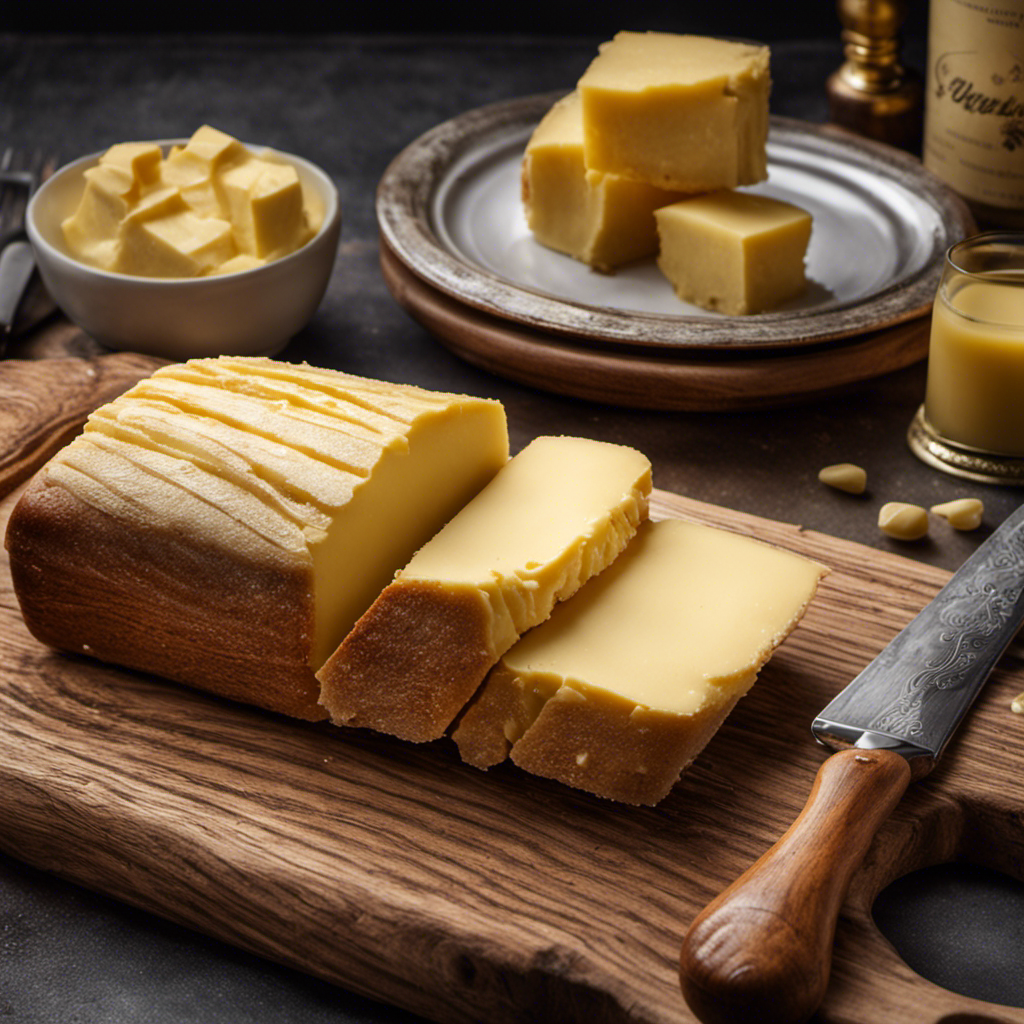As a pet owner, I have always been vigilant about my dog’s diet. Have you ever thought about what would happen if your furry companion accidentally ingests butter? The results might surprise you.
In this article, we will delve into the potential digestive issues, the risk of pancreatitis, and the increased calorie intake that can occur when a dog consumes butter. So sit tight, because you’re about to learn some eye-opening facts about the effects of butter on our canine friends.
Key Takeaways
- Butter can be difficult for dogs to digest and can lead to digestive issues such as upset stomach and diarrhea.
- Excessive consumption of butter can cause pancreatitis, a serious inflammation of the pancreas, in dogs.
- Dogs should be kept away from small objects, bones, and toys to prevent choking, and the Heimlich maneuver can be used to dislodge objects from a choking dog’s airway.
- Feeding dogs butter or fatty foods should be avoided to prevent choking incidents, and healthier alternatives such as mashed avocado or coconut oil are recommended.
Potential Digestive Issues
If a dog eats butter, it can cause potential digestive issues. Butter is high in fat, which can be difficult for dogs to digest properly. The fat content in butter can lead to an upset stomach, diarrhea, and even pancreatitis in some cases.
Dogs have a different digestive system than humans, and their bodies are not designed to process large amounts of fat. Additionally, consuming excessive amounts of butter can contribute to weight gain and increase the risk of obesity in dogs. Obesity has been linked to a variety of health issues in dogs, including joint problems, heart disease, and diabetes.
Therefore, it is important to keep butter and other high-fat foods out of a dog’s reach to prevent potential digestive issues and weight gain.
Risk of Pancreatitis
As a responsible pet owner, it’s important to understand the risk of pancreatitis in dogs and the role that butter can play in triggering this condition.
Pancreatitis is a serious inflammation of the pancreas that can be caused by a high-fat diet, such as consuming butter. The dog’s pancreas is not designed to handle large amounts of fat, and this can lead to the development of pancreatitis.
Pancreatitis can be life-threatening if left untreated.
Butter and Pancreatitis
Butter can potentially contribute to the development of pancreatitis in dogs. While it may not directly cause pancreatitis, the high fat content in butter can lead to weight gain in dogs, which is a risk factor for pancreatitis.
Excessive consumption of butter can overload the pancreas, causing inflammation and the release of digestive enzymes that can damage the pancreas itself. The pancreas plays a crucial role in the digestion of fats, proteins, and carbohydrates, producing digestive enzymes that help break down food. However, when the pancreas is overwhelmed, the enzymes can start attacking the pancreas itself, leading to pancreatitis.
It is important to limit a dog’s consumption of butter and other high-fat foods to prevent weight gain and reduce the risk of pancreatitis.
Dog’s Pancreas and Risk
The risk of pancreatitis in dogs can be increased by consuming high-fat foods such as butter. Dogs have a different digestive system compared to humans, and their pancreas plays a crucial role in breaking down fats. However, their pancreas may struggle to handle the high-fat content in butter, leading to inflammation and potentially pancreatitis. As a dog owner, I’ve always been curious about how my dog’s digestion works and what happens when they eat certain foods. When it comes to butter consumption, it is important to understand the impact it can have on a dog’s pancreas. It is essential to be mindful of what we feed our furry friends and avoid giving them foods that can put their pancreas at risk.
Choking Hazard
As a veterinarian, it is crucial to have knowledge about the Heimlich maneuver for dogs, as well as the signs of choking, in order to provide immediate and potentially life-saving care.
The Heimlich maneuver is a technique used to dislodge foreign objects from a dog’s airway by applying pressure to the abdomen.
Common signs of choking in dogs include pawing at the mouth, difficulty breathing, and a distressed or panicked appearance.
To prevent choking incidents, it is important to keep small objects, bones, and toys that can be easily swallowed out of a dog’s reach, and to always supervise them during meal times.
Awareness about these potential hazards and knowing how to respond can make a significant difference in the outcome for a choking dog.
Heimlich Maneuver for Dogs
If your dog starts choking on something like butter, you can perform the Heimlich maneuver to help dislodge the object. However, it is important to note that the Heimlich maneuver should only be performed by individuals who have been trained in its proper execution. If you are not confident in performing the maneuver or if it is not effective, it is recommended to seek immediate veterinary assistance. There are also alternative methods that can be used as first aid for choking dogs. These include back blows, chest compressions, and the use of a modified Heimlich maneuver for small dogs. Table 1 provides a comparison of the Heimlich maneuver and its alternatives for choking dogs.
| Technique | Description |
|---|---|
| Heimlich maneuver | Abdominal thrusts to dislodge the object |
| Back blows | Firm strikes between the shoulder blades |
| Chest compressions | Firm compressions on the chest to expel the object |
| Modified Heimlich | Similar to the Heimlich maneuver but with modified force |
Signs of Choking
Pay attention to the signs of choking in your dog, such as difficulty breathing, pawing at the mouth, and gagging sounds.
Choking in dogs can be a life-threatening emergency that requires immediate action. When a dog chokes, their airway becomes obstructed, preventing them from breathing properly. It is crucial to recognize these signs and respond quickly.
If your dog is conscious but choking, you can perform the Heimlich Maneuver by applying firm pressure to their abdomen, just below the ribcage. This can help dislodge the object causing the obstruction.
However, if your dog is unconscious, it is important to perform CPR and seek veterinary assistance immediately.
By being aware of the signs of choking and knowing how to respond in an emergency, you can help save your dog’s life.
Moving forward, let’s explore prevention and awareness strategies to reduce the risk of choking incidents in dogs.
Prevention and Awareness
To prevent choking incidents in dogs, it’s important to be aware of potential hazards and take proactive measures.
One effective prevention measure is to avoid feeding dogs butter or any other fatty foods. Butter can be particularly dangerous because it is rich in fat and can easily become lodged in a dog’s throat, leading to choking. Instead of butter, it’s recommended to use butter alternatives such as mashed avocado or coconut oil, which are healthier options for dogs.
Additionally, it’s crucial to supervise dogs while they are eating and ensure they are chewing their food properly. Providing appropriate-sized treats and toys can also help prevent choking incidents.
Increased Calorie Intake
Eating butter can lead to an increase in calorie intake. Butter is a high-calorie food, with approximately 100 calories per tablespoon. This can have negative effects on weight, as excessive calorie intake can lead to weight gain. Additionally, butter is a source of saturated fat, which is known to contribute to various health issues, including heart disease. It is important to be mindful of our butter consumption and consider healthier alternatives.
| Butter | |
|---|---|
| Calories per tablespoon | 100 |
| Fat content | 11 grams |
| Saturated fat | 7 grams |
| Effects on weight | Can contribute to weight gain due to high calorie content |
| Digestive problems | Excessive consumption may lead to digestive discomfort and diarrhea |
Effects on Blood Lipid Levels
Consuming excessive amounts of butter can negatively impact blood lipid levels, potentially increasing the risk of heart disease. When we consume butter, it is primarily composed of saturated fats, which can raise levels of LDL cholesterol, also known as ‘bad’ cholesterol, in the blood. Studies have shown that high intake of saturated fats, like those found in butter, can lead to an increase in total cholesterol and triglyceride levels.
This can disrupt the balance between ‘good’ and ‘bad’ cholesterol, promoting the formation of plaques in the arteries. These plaques can restrict blood flow and increase the risk of heart disease and stroke.
It is important to consume butter in moderation and to opt for healthier alternatives, such as olive oil or avocado, which contain healthier fats that can actually benefit blood lipid levels.
Allergic Reactions
Excessive butter consumption can trigger allergic reactions in some individuals, such as hives or difficulty breathing. Allergic reactions occur when the immune system mistakenly identifies certain components of butter as harmful substances. This can lead to the release of histamine and other chemicals, causing symptoms ranging from mild itching to severe anaphylaxis. It is important to note that allergic reactions to butter are relatively rare, but individuals with a known allergy to dairy products should exercise caution.
In addition to allergic reactions, increased calorie intake is another potential concern with excessive butter consumption. Butter is high in both saturated fat and calories, which can contribute to weight gain and increase the risk of developing obesity-related health issues. Therefore, moderation is key when it comes to butter consumption.
Moving on to the next topic of potential toxicity…
Potential Toxicity
Butter can sometimes contain trace amounts of toxins, so it’s important to be aware of potential risks associated with its consumption.
There is a possibility of developing a potential allergy to butter, which can lead to various allergic reactions. These reactions can range from mild symptoms like itching, hives, or swelling, to more severe reactions such as difficulty breathing or anaphylaxis.
Additionally, consuming butter in large quantities or by individuals with lactose intolerance can result in digestive distress. This can manifest as symptoms like bloating, diarrhea, or abdominal pain.
It is crucial to be mindful of these potential risks and to consult with a healthcare professional if you suspect any adverse reactions or digestive issues after consuming butter.
Impact on Gastrointestinal Flora
Understanding the impact of butter on gastrointestinal flora can help individuals make informed choices about their dietary habits. The gastrointestinal health is closely linked to the overall well-being of our digestive system. Here are some key points to consider:
- Butter consumption can disrupt the balance of beneficial bacteria in the gut, leading to an imbalance in the gastrointestinal flora.
- This imbalance can negatively affect the digestive system‘s ability to break down and absorb nutrients properly.
- The high fat content in butter can also contribute to inflammation in the gut, which can further disrupt the gastrointestinal health.
Maintaining a healthy gastrointestinal flora is essential for optimal digestion and overall well-being. While butter can be enjoyed in moderation, it is important to be mindful of its potential impact on the digestive system and to prioritize a balanced diet that promotes gastrointestinal health.
Long-Term Health Consequences
To maintain my long-term health, it’s important to be mindful of the potential consequences that can arise from prolonged consumption of butter.
While butter can be delicious and add flavor to many dishes, it is high in saturated fats and calories. Consuming too much butter can lead to potential weight gain, as it is calorically dense and can contribute to an imbalance in energy intake.
Additionally, the high fat content in butter can impact nutrient absorption. Fat can interfere with the absorption of certain vitamins and minerals, such as fat-soluble vitamins A, D, E, and K.
Therefore, it’s important to consume butter in moderation and balance it with a variety of other nutrient-rich foods to maintain optimal long-term health.
Frequently Asked Questions
Can Dogs Eat Butter in Moderation Without Experiencing Any Negative Health Effects?
Dogs can consume butter in moderation without negative health effects. However, excessive consumption may lead to pancreatitis, obesity, and stomach upset. It’s important to consult with a veterinarian before introducing butter into a dog’s diet.
What Are Some Signs and Symptoms of Pancreatitis in Dogs?
Pancreatitis symptoms in dogs can include vomiting, abdominal pain, and loss of appetite. Treatment for pancreatitis in dogs typically involves medication, a low-fat diet, and supportive care. It’s important to consult a veterinarian for proper diagnosis and treatment.
Is It Safe for Dogs to Consume Small Amounts of Butter on a Regular Basis?
It is generally not safe for dogs to consume small amounts of butter on a regular basis. While some dogs may tolerate it well, others may experience digestive issues or butter allergies.
Can Dogs Develop Allergies to Butter?
Can dogs have butter as a treat? Are there any health benefits of feeding butter to dogs? It is important to consider possible allergies and the high fat content. Consult a veterinarian for specific dietary advice.
Are There Any Natural Alternatives to Butter That Dogs Can Safely Consume?
There are natural alternatives to butter for dogs, such as coconut oil or pureed pumpkin. Feeding dogs a butter-free diet can have benefits like reducing the risk of pancreatitis and maintaining a healthier weight.
Conclusion
In conclusion, if a dog eats butter, it can lead to various digestive issues, including potential pancreatitis. It can also pose a choking hazard and increase the dog’s calorie intake, leading to weight gain.
Additionally, butter can affect blood lipid levels and cause allergic reactions in some dogs. There is also a potential for toxicity if the butter contains certain additives.
Furthermore, the consumption of butter can disrupt the dog’s gastrointestinal flora, which may have long-term health consequences. Interestingly, a study found that approximately 5% of dogs experience pancreatitis after consuming fatty foods like butter.










